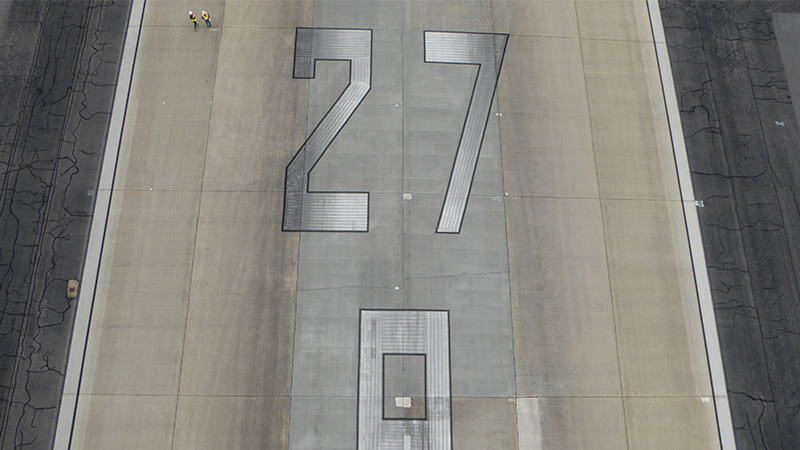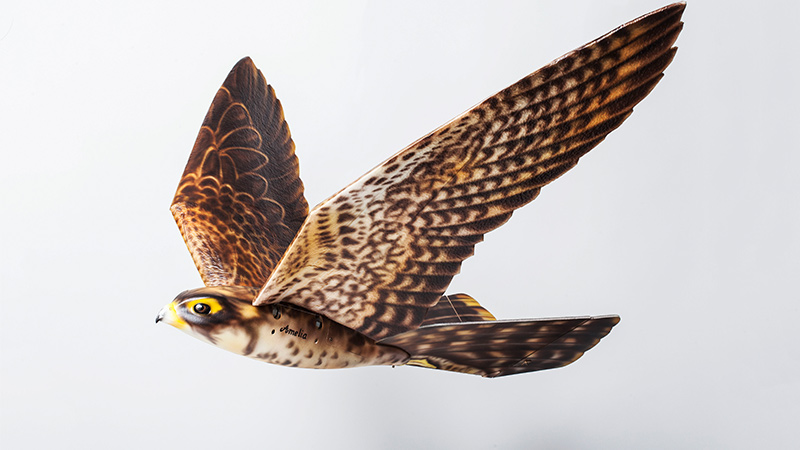Stay Up to Date
Submit your email address to receive the latest industry and Aerospace America news.
Airline industry embraces drones as cost-saver
A pilot since the age of 18, Jim Duguay was in his 40s when he took up flying drones for his employer, Pittsburgh-based Michael Baker International, whose line of business includes civil engineering and consulting for airports. When he first flew a 3.06-kilogram quadcopter over the longest runway at Hartsfield-Jackson Atlanta International Airport to look for pavement stress and other signs of deterioration, he came away impressed by drones.
“I think they’ve almost become like flying iPads now,” he says. “The automation that is put into the technology is amazing.”
Duguay’s wake-up call is being mirrored across the aviation industry. Just a few years ago, much of the talk about drones and airplanes was about the danger they presented to passenger planes. As drones proliferated among hobbyists, filmmakers and others, so did concerns about what would happen if one crashed into an airplane, got sucked into an engine or caused a pilot to swerve out of its way.
“Three years ago, it was ‘No, stay away, don’t invade the airspace” with drones, says Jordan Cicoria of Aerium Analytics, which has been flying a drone to scare birds away from the Edmonton International Airport in Alberta, Canada. “But you’re having a lot more people start to embrace it.”
Today, the conversation is still about keeping airspace safe for planes that carry people. But it’s also shifting to the ways in which drones can help the aviation industry lower costs, become more efficient and — yes — safer. In the case of runway maintenance, for instance, the drone’s high-resolution camera picks up things the human eye might miss and makes it easier for engineers to spot structural changes over time.
Most new uses of drones in aviation are still in their experimental stages, with Canada and European countries ahead of the United States in that regard. Duguay’s two drone flights at Atlanta’s airport are still being evaluated for their benefits, while the Edmonton flights are a five-day-a-week part of the wildlife control program. But few doubt that the world’s biggest aviation market will catch up.
As John Goglia, head of the Professional Aviation Maintenance Association and a former member of the National Transportation Safety Board, says: “I suspect the United States will be in with both feet in the near future.”
Aircraft inspection time-saver
In Europe, two companies are touting drones for the inspection of commercial airliners, a job they can complete in a fraction of the time it takes humans to do. Today, speeding up inspections would reduce aircraft downtime and reduce expensive man-hours spent towing aircraft into hangars and pulling out scaffolding and cherry pickers to reach the upper parts of the plane. Drones can be programmed to fly around and photograph planes — using different flight paths for each make of plane — in about a fifth or less of the time it now takes.
“It’s still early but there certainly is a lot of interest from airlines and companies in reducing the time it takes to do normal visual inspections,” says Gavin Goudie of Blue Bear Systems Research, co-developer of an inspection drone called RAPID (Remote Automated Plane Inspection & Dissemination) that’s being tested by London-based easyJet.
A quadcopter with a half-meter wing span, RAPID has electro-optical sensors that detect damage from lightning strikes, hailstones and other hazards, while a lidar sensor helps guide it.
Maintenance workers automatically deploy RAPID, although they can assume manual control.
“The big win,” Goudie says, is that skilled employees can spend more time analyzing data collected by the drones, instead of manually conducting the inspections themselves.
The drone’s avionics keep it at least 1 meter away from the aircraft it’s inspecting, to avoid damaging it, and feature a collision avoidance system to dodge people or objects that might come into its path. Operating inside a hangar is an advantage, since licenses aren’t required to operate a drone in “private field environments” in most countries, Goudie says.
Some two years after the first demonstration drone, Goudie says the company is “very close to getting our system deployed,” with other airlines in Europe and the U.S. interested in it as well.
“The whole point of the system is it’s not another drone, it’s another tool for the aircraft industry,” Goudie says.
Donecle, a France-based developer of aircraft inspection drones, has been testing its 80-by-80-centimeter drone with Air France-KLM Engineering & Maintenance for about the same period. Josselin Bequet of Donecle says fully automating the drone — “removing the pilot and having the drone fly on its own” — was the key to making it attractive to potential users.
According to the company’s website, starting an inspection “is as simple as selecting your aircraft type, setting the drone next to the aircraft and hitting ‘Go.’” More than one drone can simultaneously inspect a larger aircraft.
The drone was initially flown to inspect regulatory stickers on aircraft, but the company realized it could expand its role to spotting lightning damage, says James Kornberg, director of engineering and maintenance innovation for Air France.
A drone can complete an inspection in 20 minutes, compared to the five hours it takes employees, and the data it collects is automatically stored and easily traceable in a secure cloud-computing environment, Kornberg says. Donecle’s website says it costs $27,000 to completely inspect a commercial aircraft using traditional methods, not figuring in the $80,000 lost while the aircraft is on the ground.
Bequet says the drones have inspected hundreds of A320s and other aircraft. “The solution is pretty much operational,” and Donecle expects it to be rolled out across airports serviced by Air France in the near future.
Airbus announced last year that it is testing drones to inspect its A330 aircraft. According to the Airbus website and a YouTube video posted by the company, the drone digitally photographs the upper part of the aircraft during the final inspection when the manufacturer is looking for cosmetic defects such as scratches and dents. The drone can cover an aircraft in 10 to 15 minutes, compared to the two hours it takes a human (although a human must review the photographs). The drone helps prevent worker injuries because an employee no longer has to go up in a lift to see the top of the plane, according to the company. Airbus said the drones would be tested on other aircraft beginning this year.
Preventing wildlife incursions
Reducing the time and cost involved in inspections might be the biggest potential benefit of drones in aviation, but it’s not the only one. Edmonton International Airport in Canada earlier this year started flying a drone for wildlife control, specifically to scare birds away from the paths of aircraft.
The drone, called Robird, weighs just 750 grams and, with its flapping wings, looks to other birds like a falcon attacking its prey. It was developed by Clear Flight Solutions of the Netherlands and is operated at the airport by Aerium Analytics of Calgary. The partnership between Aerium and Clear Flight came about after a meeting among executives at an aerospace conference in Japan. Robird had previously been assigned to chase birds away from an orchard, among other applications.
“We immediately saw the need for technology like that in airports in North America,” Cicoria said.
Under Transport Canada rules, the drone can only be flown 122 meters high and the same distance away from active planes. Anyone flying in or out of the airport is notified of Robird’s scheduled flights. The drone, which is steered by a pilot on the ground, can be dropped to the ground quickly if an aircraft appears in the area.
“Obviously, safety is absolutely paramount with these operations,” says Dean Ervin, the airport’s director of airside operations.
Ervin thinks it’s too soon to determine Robird’s effectiveness in controlling wildlife compared to traditional methods, although birds certainly seem to be afraid of it.
As far as safety, he says, “Obviously with drones in an airport, everybody gets a little nervous.” That being said, “We’ve had no issues whatsoever.”
Several other airports in Canada have expressed interest in Robird.
Duguay says there’s also been some interest from airports in scanning runways for debris, typically parts from aircraft, with drones.
In 2000, an Air France Concorde was brought down by a small metal strip on a runway at Charles De Gaulle Airport. The strip ruptured a tire during takeoff, and the resulting debris pierced one of the plane’s fuel tanks as it went airborne, causing a crash that killed all 109 aboard and four people on the ground.
“Drones are not going anywhere, so we’re embracing the technology, but we’re also making sure the safety requirements are followed to the nth degree,” Ervin says.
“It’s all about trust”
Aerium Analytics has flown a second, more traditional drone to map the Edmonton airport’s runway and other features. Other possible uses for drones that have been discussed within the aviation industry include airport security, disaster response and the delivery of airplane parts.
“It’s all about trust” between drone operators and aviation industry members, Cicoria says.
So far, the best-known use of drones in the U.S. aviation industry has come at Atlanta’s airport. A drone helped plan a construction project in February and another photographed 27R, looking for defects on the longest runway at the busiest airport in the world. Duguay piloted the drone on those mapping missions. Such flights need special approval by the FAA and were conducted while the 3,776-meter-long runway was not in use, at a height of 30 meters. The job took about half as long as a traditional inspection.
“Rather than doing visual on-foot pavement inspections, we utilized drones to collect high-resolution images. The thought was that would reduce downtime of the runway,” Duguay says, noting that the drone is capable of collecting “a lot more information than you would on foot.” More recently, the drone took video of a 5K footrace held on a runway at night at Hartfield-Jackson. While not directly related to aviation, the flight showed the FAA’s willingness to allow drones to fly in airport space under a waiver process. Duguay says airports and the FAA are in a “learning process” regarding drones.
“Airports have been spending a lot of time ensuring that drones stay away from airports, for good reasons,” he says. “There’s a large hobbyist market out there and there’s very little guarantee that these folks will follow all the safety regulations.”
But as drone technology improves to include safeguards such as geofencing, he adds, some airports are getting more comfortable with the idea of deploying them. “It goes down to the individual airport as far as whether they’re interested in it.” Duguay notes that in the case of the Inspire quadcopter he flew, he had to work with the manufacturer, DIJ, to disable the lock that would otherwise prevent it from flying in airport airspace.
Goglia of the Professional Aviation Maintenance Association has no doubt the aviation industry will continue to find uses for drones, just as so many other industries are.
“It’s moving into every facet of our lives,” he says. “Anywhere where it’s more convenient to take a view from above, you’re going to see drones in use. This is emerging technology. This is just starting.”
"The whole point of the system is it’s not another drone, it’s another tool for the aircraft industry."
Gavin Goudie of Blue Bear Systems Research
About Joe Stumpe
A freelance reporter based in Wichita, Kansas, Joe has written for The New York Times, Agence France-Presse and The Huffington Post.
Related Posts
Stay Up to Date
Submit your email address to receive the latest industry and Aerospace America news.







